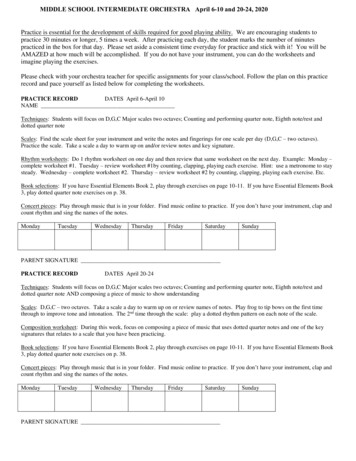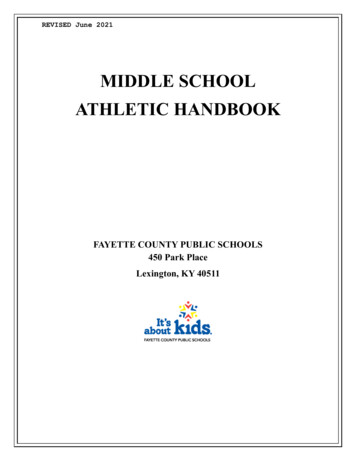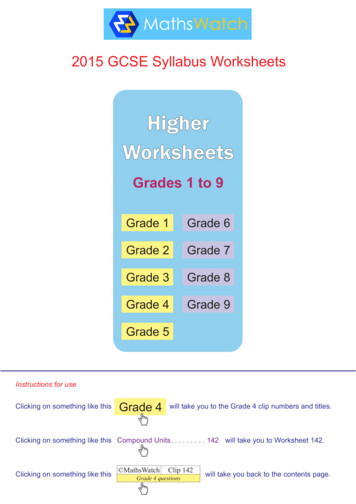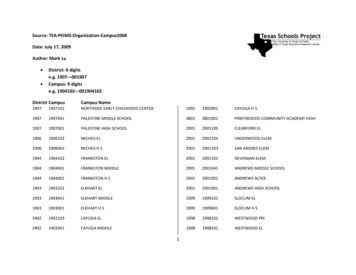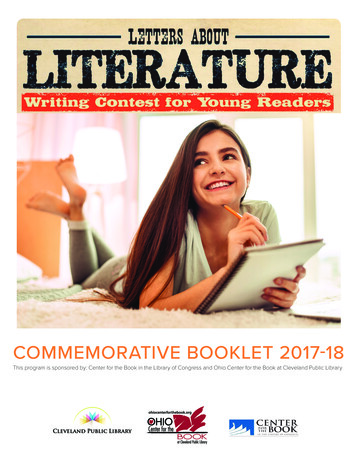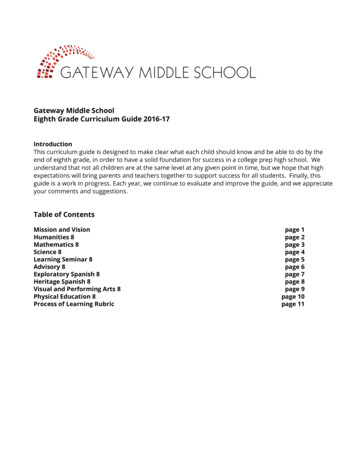
Transcription
Gateway Middle SchoolEighth Grade Curriculum Guide 2016-17IntroductionThis curriculum guide is designed to make clear what each child should know and be able to do by theend of eighth grade, in order to have a solid foundation for success in a college prep high school. Weunderstand that not all children are at the same level at any given point in time, but we hope that highexpectations will bring parents and teachers together to support success for all students. Finally, thisguide is a work in progress. Each year, we continue to evaluate and improve the guide, and we appreciateyour comments and suggestions.Table of ContentsMission and VisionHumanities 8Mathematics 8Science 8Learning Seminar 8Advisory 8Exploratory Spanish 8Heritage Spanish 8Visual and Performing Arts 8Physical Education 8Process of Learning Rubricpage 1page 2page 3page 4page 5page 6page 7page 8page 9page 10page 11
Gateway Middle School Mission and VisionMission StatementGateway Middle School supports and challenges all students to discover their unique potential, activelyparticipate in their community, and develop skills and habits to achieve excellence in high school andcollege.Vision StatementGateway Middle School is a model, college preparatory charter school committed to academic excellencethrough personalized, student-centered learning. Gateway Middle School combines a rigorous academicprogram with an approach where the individual talents and strengths of its students are identified andsupported. Working with teachers committed to our mission, Gateway Middle School students will acquirethe skills, habits, and knowledge necessary for academic and personal success in a college preparatoryhigh school, in college and in adult life.Gateway Middle School's values of personal integrity, responsibility, and respect for others should inspirestudents to contribute to their communities however they can. By attending a school which fully embracesthe diversity of the Bay Area, Gateway Middle School students will appreciate what they have in commonwith those who are different and value what they learn from one another.A Commitment to Partnership with FamiliesAt Gateway, we believe that parents and guardians play a vital role in the education of their children .While the middle years tend to be a time when students yearn for greater independence from theirfamilies, it is also a time when family involvement remains essential to students’ academic success.Gateway is committed to working with parents to reach the academic and social goals necessary forstudent success in middle school and beyond. This guide is one way in which we seek to bring parentsand teachers together to support success for all students.To encourage continued family involvement during this critical transition from elementary school tomiddle school and on to high school, Gateway Middle School also provides many other opportunities formeaningful family participation, including: Family Information Nights Parent-Teacher-Student and Student-Led Conferences Student Exhibition Nights Gateway Parents Association (GPA) School Site Council (SSC) Flexible volunteer opportunities at school1GMS Eighth Grade Curriculum Guide 2016-17
Grade 8 Year-End Learning Goals and Expectations for HumanitiesBy the end of the school year, all eighth grade students should be able to write narratives, informational and argumentative essays that clearly convey experiences, arguments andideas using primary and secondary sources as solid evidence use a multi-draft writing process to brainstorm, write, revise and edit works of fiction and nonfiction compare, contrast, and analyze texts, ideas and conflicting pieces of information identify and comprehend literary elements within a narrative develop and use academic vocabulary in writing and academic conversations understand how the United States of America became a formal nation and the challenges that surroundedits development analyze the geographical, physical and political changes of the United States understand how personal, familial, cultural and national identities are formed and interact with each otherUnits of study1. The Colonies demand IndependenceEssential Question: How does identity shape behavior and decision-making? How is “us” versus “them” formed?Reading: Determine theme and analyze connections; Chains by Laurie Halse AndersonWriting: Narrative and Explanatory Writing2. Founding and Expanding a NationEssential Question: How is a “free” nation and its laws established? How can the government and people be heldaccountable for equal protection under these laws?Reading: Analyze dialogue, author’s word choice, and elements of plot; The Absolutely True Diary of a Part TimeIndian by Sherman AlexieWriting: Argumentative Writing3. A Changing NationEssential Question: How can the government and people be held accountable for equal protection under ournation’s laws? What happens when we disagree on fundamental issues to govern the nation and ourselves?Reading: Compare and contrast text structures, cite evidence and evaluate arguments; Warriors Don’t Cry byMelba Pattillo BealsWriting: Argumentative and Explanatory Writing4. Rebuilding the Nation to become a World PowerEssential Question: How has the American identity evolved? How does social change occur?Reading: Analyze viewpoints, identify literary elements; Fahrenheit 415 by Ray BradburyWriting: Argumentative and Narrative WritingAssessments / sources for grades: Independent and group work; Do Nows & Exit Tickets; Unit tests and quizzes;Process of Learning assessments; Student class participation and collaboration; Writing Rubrics and Checklists;Writers’ Notebooks; Essays and Projects; HomeworkCurriculum approach used TCI History Alive! The United States Through Modern Times Novels and Poetry Nonfiction Articles and Primary Source DocumentsGrade 8 Year-End Learning Goals and Expectations for Mathematics2GMS Eighth Grade Curriculum Guide 2016-17
By the end of the school year, all eighth grade students should be able to Recognize and modeling linear relationships in bivariate data Develop understanding of equivalent expressions and equations Identify properties of exponents and apply exponential rules in order to simplify expressions Use graphic and algebraic methods to model and solve systems of equations Deepen understanding of three-dimensional figures (e.g. volume of non-rectangular prisms and compositefigures). Understand the necessary conditions for establishing congruence or similarity of polygons usingtransformations Understand and apply the Pythagorean TheoremEssential Questions1. How can functions model data patterns? How do linear patterns help us understand physical phenomenaaround us?2. How can we discover and use properties of exponents to simplify expressions.3. How do properties of operations help generate equivalent expressions and reveal new information about thecontext of a problem?4. How can you determine the approach to solving a system of equations? How can you use system of equationsto solve real-world problems?5. How could properties of rectangular prisms help deepen understanding of more complex non-regular prisms?6. How can transformation effects help you compare figures? How can properties of transformations,congruence, and similarity be used to solve problems about shapes and measurements?7. How can you construct an argument that proves the relationship of the legs to the hypotenuse of a righttriangle? How can the converse of the Pythagorean Theorem determine whether it is a right triangle?Assessments / sources for grades: Classwork/Teamwork/Participation Homework Process of Learning assessments Tests/Quizzes and ProjectsCurriculum approach usedStudents will gain both procedural and conceptual understanding of Algebraic and Geometric topics this year. Theprimary curriculum, Connected Mathematics Program, will emphasize a collaborative, small group approach tomathematical problem-solving as well as physical modeling and revision process.Grade 8 Year-End Learning Goals and Expectations for ScienceBy the end of the school year, all eighth grade students should be able to Plan, carry out and evaluate investigations using appropriate tools3GMS Eighth Grade Curriculum Guide 2016-17
Develop, use and revise models to explain a scientific phenomenaConstruct and present arguments to support conclusions about physical phenomenaIdentify and describe the forces acting on a single objectDemonstrate that the change in an object’s motion depends on the sum of the forces on the objectand the mass of the objectExplain how chemical reactions occur on an atomic levelExplain how particles interact to create the properties of matterAnalyze and interpret patterns to describe the properties and motion of the universeIdentify human impact on the Earth and the environmentEssential Questions1. What are science and engineering? How do science and engineering work? How do scientists andengineers work together to solve problems?2. What forces act on an object on earth? How do forces affect the objects they act on?3. How do objects move? What affects objects’ motion?4. What are we made of? What makes a substance unique? How do substances change?5. What makes up the universe? How do objects in the universe affect each other, as well as life on Earth?6. What impact did humans have on the history of earth? What impact do humans continue to have on theearth?Assessments / sources for grades: Class work/Group work/Participation Process of Learning assessments Science Notebooks Homework Tests/Quizzes ProjectsCurriculum approach usedWe will be using a variety of curricula in Physical Science this year, including the project-based It’s AboutTime (IAT) curriculum, the Full Option Science System (FOSS), and lessons created from various onlinesources. Our student scientists will develop their scientific and engineering design skills in each unit bydocumenting their learning in their science notebooks.4GMS Eighth Grade Curriculum Guide 2016-17
Grade 8 Year-End Learning Goals and Expectations for Learning SeminarBy the end of the school year, all eighth grade students should be able to Use literacy strategies such as inferencing, decoding, connecting, summarizing, and using contextclues to comprehend higher complexity texts Cite textual evidence to analyze and evaluate central idea, author’s purpose, arguments andconflicting information within a text Incorporate academic strategies such as organization, collaboration, self-awareness andself-advocacy to help with academic success Identify and practice habits of growth mindset vs. fixed mindset students Demonstrate ability to set goals, reflect, monitor, and revise as needed Identify and understand different parts of the brain, their function, and the neuron Explain the different branches of psychology and identify examples of theories in everyday lifeUnits of study1. Reading is Thinking: Understanding who we are as readers and learners and developing strategies togrow in both these areasEssential Question: How do I set myself up for success as a reader and thinker? How did the field of psychologydevelop and how can it help us understand ourselves and interactions with others?2. Expanding our skills: Deepening our analysis of texts and brain science; Introduction to psychologyEssential Question: How do we use collaboration to interact with and better understand information? How didthe field of psychology develop and how can it help us understand ourselves and interactions with others?3. Evaluating arguments and multiple points of view: Introduction to psychology and conflictingevidenceEssential Question: How does psychology help us understand human difference? Why is it important toquestion information?4. Transferring our knowledge to others: Pursuing information independently and teaching it to othersEssential Question: How do I pursue additional knowledge on a subject independently? How do I present whatI know in a way that is engaging and logical?Assessments / sources for grades: Independent and group work; Independent Reading; Unit tests and quizzes; Process of Learningassessments; Student class participation and collaboration; Reader’s Response Notebooks;Projects; HomeworkCurriculum Approach Used Step-It-Up 2 Thrive, Thrive Foundation Psych 101: A crash course in the science of the mind Balanced Literacy including Guided Reading, Literature Circles, Reader’s Response Notebooks andvocabulary study5GMS Eighth Grade Curriculum Guide 2016-17
Grade 8 Learning Goals and Expectations for AdvisoryAdvisory Goals and Objectives: To foster a positive school climate as students develop positive relationships. To know every student in the school well. This will help students’ need to belong to a group, and tohelp students feel accepted and valued by teachers and peers. For each student to have a meaningful connection with an adult. This insures that every student isknown well by at least one adult in the middle school. This adult is able to support the student intimes of difficulty, to recognize the warning signs of teen problems, as well as to celebrate thestudent’s successes. Personalize the school curriculum by providing a forum to address topics of concern for youngadolescents and also addressing significant and unexpected events in an arena with a higher levelof trust and concern than is found in the average classroom. Form consistent partnerships with families and keep communication flowing between home andschool.What is Advisory?Advisory is a vital component of the middle school concept and is designed to offer students a safeenvironment in which they can develop and strengthen their social-emotional skills and build a sense ofcommunity within our school. The class incorporates community circle, social skills curriculum forsocial-emotional skills, Tribes activities, interest-based clubs, and academic advising. Advisory providesstudents with an advisor who they can seek when needing academic and social advising. Each of the corevalues of community, respect, responsibility, and excellence will be the focus of the course while studentslearn and practice social-emotional skills and make Advisory a place to celebrate each other. It is a time ofcamaraderie, support, and learning.Advisor RoleThe advisor acts as a mentor to the students in his or her group, guiding their academic education andsupporting their social and emotional development. Ideally, advisors also act as the central contact personbetween the school and their advisees’ families. Advisors will help guide conversation around changescommon to middle school students, peer relationships, study skills, school values, goal setting, college andcareer exploration, problem solving, decision-making, and community service.Advisory Structure Each advisory is made up of 15-18 students in the same grade level. Advisories meet five days a week unless there is a scheduled assembly.Curricular Content of Advisory 8: Focus: Upstanders and Civic Responsibility Project: Community Service and Generation Citizen Social Skills: Empathy and Communication, Bullying Prevention, Emotion Management, GoalSetting, Substance Abuse Prevention College awareness with college visit in the spring High school decision-making and application process in the fall6GMS Eighth Grade Curriculum Guide 2016-17
Grade 8 Learning Goals and Expectations for Exploratory SpanishBy the end of the year, all 8th grade Exploratory Spanish students should be able to pronounce Spanish words using the sounds of the Spanish alphabet.follow along with songs and read alouds in Spanish.comprehend simple questions asked in Spanish.ask routine classroom questions in Spanish.use formulaic language (learned words and phrases).attempt to speak or answer a question using Spanish even if it is only one word before switching toEnglish. write simple sentences in Spanish. Units of studyCultural Context:MéxicoGuatemalaNicaraguaEl SalvadorParaguayPeruHondurasVenezuelaBoliviaTV ShowLanguage Focus:Alphabet / Greetings / Numbers (1-30) / “hay”Basic Geography Terms / The Classroom / NounsDefinite & Indefinite Articles, Plural FormsWeather / Seasons / Dates & Holidays / Present Tense –ER / –IR VerbsThe Family / Subject Pronouns / “ser - to be” & “estar - to be” / Adjectives/Feelings & EmotionsPossessive Pronouns / “tener - to have” / Telling Time / Question Words”At Home/ Estar & Locations/ Tener & Obligations/ Hay que/ On the PhoneClothing / Colors / Shopping / Numbers (100 ) / Adjectives / Present Tense –AR VerbsBody Parts/ “Boot Verbs”/ Estar & ConditionsIn Your City/ Prepositions & LocationsMi Vida Loca (BBC Channel)Assessments / sources for grades Class ParticipationNote-Taking EffortsAssignment CompletionReflective Cultural Diary EntriesGroup Participation and Presentations Spoken Language Tasks to PracticeVocabulary & Language SkillsMaintenance of a Spanish FolderPerformance based assessmentsProjectsCurriculum approach used Teaching Proficiency Through Reading and Storytelling, TPRS¡Bienvenidos! An Introduction to Spanish Language Studies, VOCES 1st Year Spanish by Teacher’sDiscovery, and excerpts from other language materialsQuia and other online practice and play sitesLanguage games7GMS Eighth Grade Curriculum Guide 2016-17
Grade 8 Learning Goals and Expectations for Heritage SpanishBy the end of the year, all 8th grade Heritage Spanish students should be able to use the sounds of the Spanish alphabet to improve spelling.read aloud in Spanish.feel more comfortable speaking Spanish in front of a group.use accent marks to maintain the original pronunciation of word stems.punctuate Spanish style.apply new grammar and vocabulary to improve written expression in Spanish.Units of studyContent Codes:A. Geographical Focus B. Historical / Cultural FocusC. Literary ExposureD. Written Expression TaskE. Spanish / English Grammar Comparisons1. Leyendas y Vida: A. Latinoamerica; B. Hispanic and Latin Myths and Legends; C. Folk Stories. D. Write a play;E. Pronouncing and Spelling H, Ll, Y / Reflexive Verbs2. PoesíaA. Chile B. Hispanic Celebrations & Holidays C. Defining Poetry & the MajorLiterary Genres D. Creating a Short Poem Using Sensory Language E. PresentTense –AR, –ER, & –IR Verbs / “Vosotros” vs. “voseo” / Prepositions “a” & “en” / Nounsthat Begin with “a” / Compound Nouns3. La novelaA. Colombia B. Hispanic Family Ties: Traditions & ChangesC. The Novel D. Describing Physical Spaces / Locations in a Narrative E. “Tohave” Verb(s) / Punctuation / Pronouncing & Spelling “b” vs. “v” / Homophones /Nouns with Both Grammatical Genders3. Arte y MusicaA. Mexico and Spain; B. Study the artwork of several Hispanic or Latino artists;C. Songs/ Rhymes/ Poetry; D. Announce and promote an event; E. Pronouncing &Spelling C, S, Z/ Infinitive VerbsLectura: “Senderos Fronterizos por Francisco Jiménez”Assessments / sources for grades Active Class ParticipationNote-Taking EffortsAssignment Completion & RevisionGroup Participation and Presentations Spoken Language Tasks to PracticeSpeaking in Front of GroupsMaintenance of a Spanish FolderPerformance based assessmentsProjectsCurriculum approach used El español para nosotros (Nivel 1) by Glencoe / McGraw-Hill Publishers Heritage Spanish Speakers’ Language Learning Strategies by Zennia Hancock, and excerpts from otherlanguage materials. Quia and other online practice and play sites Teaching Proficiency Through Reading and Storytelling, TPRS Language games8GMS Eighth Grade Curriculum Guide 2016-17
Grade 8 Learning Goals and Expectations for ArtsThe Arts Curriculum is designed to discover the unique expression of each student while using the tools of an artist. Eachgrade will work with the art lessons differently. By the end of the school year, all eighth grade Arts studentsshould be able to Apply understanding of Art Elements, Principles of Design and Visual Arts VocabularyUse artistic terms when describing the intent and content of works of art.Analyze the use of the elements of art and the principles of design in video, film, or electronic media.Skills, Processes, Materials, and ToolsDemonstrate an increased knowledge of technical skills in using more complex two dimensional art mediaCommunication and Expression Through Original Works of ArtCreate an original work of art, using film, photography, computer graphics, or video.Select a medium to use to communicate a theme in a series of works of art.Role of the Visual Arts and Diversity of Visual ArtsExamine and describe the role of a work of art created to make a social comment or protest social conditions.Compare, contrast, and analyze styles of art from Western and non-Western cultures.Discuss the contributions of women and various immigrant cultures to the art of a particular society.Make Informed JudgmentsDevelop and apply a set of criteria as individuals or in groups to assess and critique works of art.Connections and ApplicationsSelect a favorite artist and some of his or her works of art and create a piece that expresses personal ideas andviews about the artist.Careers and Career-Related SkillsWork collaboratively with a community artist to create a work of art, such as a mural, and write a report aboutthe skills needed to become a professional artist.Units of studySemester 11.2.3.4.5.6.Abstraction and Realism in Self PortraitsMaking Meaning in Symbols and GesturesPower in WordBeautiful MonstersContemporary CeramicsFashion ForwardSemester 21.2.3.Illuminated SculptureIndependent ProjectMural and Outdoor ArtAssessments / sources for grades: Sketchbooks/Journals Participation and Collaboration In-class tasks/Larger projects & Small film/research assignments Concentration and effortCurriculum approach usedThrough “hands on” and “minds on” work, students will be immersed in a variety of independent, smallgroup, and whole class activities that develop students’ understanding of historical and contemporary artpractices. The Arts curriculum seeks to promote self-awareness and purposeful expression. Students willgain experience and skills in drawing from observation and imagination as well as tools for enhancingartistic expression (collaboration, composition, public speaking, performance, etc.).9GMS Eighth Grade Curriculum Guide 2016-17
Grade 8 Learning Goals and Expectations for Physical EducationClass Overview:The main purpose of Gateway Middle School’s Physical Education Class is to help you understand, create, andfoster a healthy, positive attitude & relationship with your body. PE students will learn about exercise, plyometics,stretching, nutrition and how sleep influences our performance in exercise, sports and everyday lives. We hope togrow your mindset around healthy lifestyle and provide you with an understanding of your body and what it needsto perform, not just in PE, but in LIFE.Learning Goals:By the end of the school year, all sixth grade students should be able to learn how nutrition, exercise and healthy habits work together to create wellnessevaluate and make healthy meal choicesdemonstrate sportsmanship, teamwork and communication during activitiesunderstand the importance of cardio, flexibility, strength, balance, agility and coordinationtake skills learned in PE and apply to an active lifestyle outside of PE settingModel support toward individuals of all ability levels and encourage others to be supportive andinclusive of all individuals.Units of study1. Fitness2. Nutrition3. Team-buillding and cooperative games4. Sports (e.g. skillbuilding and learning teamwork)Class Values and Expectations:: COMMUNITY – we will aim to support and encourage each other every day. Fair play is important.Everyone is valuable AND we are stronger together. THRIVE – we will strive to do more than we thought was possible. FUN – we will come to class ready to have fun and laugh together. RESPECT – we will respect ourselves and each other. INCLUSION – we will foster a culture of inclusion. Building this culture is the most important aspect tohaving a successful year in PE. We will hold and promote a space and culture of acceptance and inclusionfor all individuals regardless of their skill level and ability. SAFETY – most important, we aim to keep each other safe.Assessments / sources for grades: Participation and effort (including proper dress) Teamwork and Collaboration Homework10GMS Eighth Grade Curriculum Guide 2016-17
Mark the box that describes how you would respond to the statements below.1I still need a lot of help withthis task/skill.Using rBinder /NotebookStudyingPresentation2I usually need my teacher’shelp with this task.3I sometimes need help withthis task.4I can do this by myself.Academic StrategiesI use the strategies and tools I learned in class to better understand the subject.1234My work is shows my own thinking & effort. It is accurately completed according to thedirections.I use the resources available to me (toolkits, extra help, peers, teachers) to betterunderstand the subject.Academic HabitsI turn in my completed homework in on time.I am on time for every class. If I am absent from school I make sure to collect and completeall of my missing work.I use my planner to write down all of my homework assignments and due dates.I keep all of my current assignments and homework in the correct folder or section of mybinder. I keep my notebook up to date. I bring all my materials to class.I use time outside of class to review material & study for tests.I give careful attention to my work so that it reflects my best effort.12341234Openness toGrowthRisk TakingSelf Awareness & Growth MindsetI know what talents and strengths I bring as a learner and use them in my learning. Iknow when I’m stuck so that I can use strategies to get unstuck.I accept my areas of challenge as opportunities to become a better learner. I try newstrategies that may help me to become a better learner.I participate in all class activities, even if the activity involves a skill I find challenging.1234Reaching outDiligence/OwnershipPersistenceSelf AdvocacyI ask for what I need when I know I need help (ex: schoolwork or social emotional)I take responsibility for my own learning, including checking my grades regularly andgetting all missing work when I miss class.When confronted with a challenge, I’ll keep giving my best effort until I get it.Collaboration & Community SkillsI show an awareness of my own emotional needs as well as the needs of others & Irespond with consideration.I listen attentively when working with others. I contribute and share the workload withmy partners for the shared success of my group.I help other members if they don’t understand or are having trouble completing thework. I also accept help from others when I am stuck on a topic.I could be paired with anybody in the class and I would work productively together withthat person to get the work done.I use strategies to understand conflicts & resolve them for the benefit of myself & mycommunity.I do the right thing for myself and others even when others are not looking.1234Self elationshipsAcceptance &OpennessConflictManagementUpstanding11GMS Eighth Grade Curriculum Guide 2016-17
Gateway Middle School Eighth Grade Curriculum Guide 2016-17 Introduction . Grade 8 Year-End Learning Goals and Expectations for Humanities By the end of the school year, all eighth grade students should be able to write narratives, informational and argumentative essays that clearly convey experiences, arguments and .
